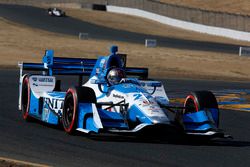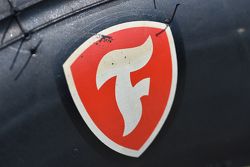How Firestone is facing the challenge of the 2018 IndyCar
IndyCar’s new-for-2018 reduced-downforce aerokits have caused Firestone to have a major rethink of all its tires. Cara Adams, chief engineer and manager of race tire development, explained to David Malsher what’s been done.

Photo by: Chris Jones






















Is making the sidewalls less stiff in response to the downforce reduction going to also make the tires breakaway in a more progressive manner and increase degradation?
No, that’s the interesting challenge. You would think that making the tires less stiff would increase tire degradation but it doesn’t always work that way, and in fact it sometimes works opposite.
The challenge for all the teams and drivers is that with a heavy reduction in aero downforce, they will be looking to increase mechanical grip and that’s where we come in… but we still need to make sure we have the appropriate amount of dropoff. We’ve gotten feedback from IndyCar and from drivers saying they want a little more tire dropoff at Texas and Phoenix. At tracks like that, when you lower the amount of downforce available, you of course have more sliding so the tires have a greater tendency to drop off, so changing the construction to make them softer could actually negate that dropoff that comes with the territory of reduced downforce.
So we need to come up with a tire that is softer in both construction and compound appropriate for the new car. And from our post-season testing at Phoenix with a couple of compound options, we were able to see the lap speeds reduce from the start of a stint to the end, and we believe we’ve come up with a good tire that we will bring to the open test in February and for the race in April.
How did you go through the process of tire selection for each track in 2018?
We were able to come with our control tires – similar to what we raced in 2017 at each of the venues – and branch out from there. The least change we saw was in road course tires. We’ll need to update some of our compounds but the construction is going to remain fairly similar to last season. There are a couple of changes to work with a car that has higher end-of-straight velocity but lower corner speed, but those are just minor construction changes.
So in summary, street course tires are going to be fairly similar, certainly to start the year; changes to road course tire construction are going to be fairly minor although their compounds will change quite a bit. Where we see the big difference in these cars are the ovals.
Is it difficult for Firestone in these circumstances, when the series is aiming to make the drivers work harder in the turns on ovals and back off for the turns more, but the drivers are asking for more grip?
Hmmm… The drivers who have been driving the new aerokits so far have a pretty good big-picture view of what the series wants and therefore what they should be asking for from the tires. We haven’t had too much of a discrepancy between those two points of view. Sometimes there is a driver who wants a tire that is the same on the first lap of a stint to the last lap of a stint but the majority want a drop-off over a stint. Most of the feedback we’ve had is pretty much in line with what IndyCar’s wishes are, so no, that hasn’t been a difficulty for us.
As far as the reads you’ve got from the teams so far, have there been any surprises, or were the simulations you ran before the 2018 car turned a wheel actually proven to be accurate?
It’s been very accurate, especially at the ovals, where the drivers are obviously looking for a lot more mechanical grip thanks to the downforce reduction. We came up with a couple of experimental compounds to work toward the right tire, but we ran a different mix of compounds in the Chevrolet test and the Honda test at Phoenix last year, so neither manufacturer has the whole picture of what we’ll run there.
And has the switch to spec aerokits meant the demands from drivers and teams is more consistent?
Yes, absolutely. It’s important when getting feedback that it is representative of as much of the entire field as possible. So it was important that we had at least one Chevrolet and one Honda car at our tests last year, but we know that with a spec aerokit their feedback will be similar.
That being said, bear in mind we do still have one major variable, and that’s the feedback between drivers – like for ovals, having one driver who likes stagger and another who doesn’t like much at all. That can alter their feedback. And on road courses driver feedback can vary considerably too. For example, what Sebastien Bourdais and Scott Dixon wanted when they used the Chevrolet aerokit was very different from what they wanted when they switched to Honda, as you’d expect. But even now that everyone runs the same kit, there’s actually still going to be a notable difference between those two because of their different driving styles and what they want from their cars.
IndyCar doesn’t often have to run in the wet, but when they do, obviously teams like to crank on as much downforce as possible. Considering there’s less downforce to add now, will that oblige Firestone to soften up its wet compound to provide more mechanical grip?
Yes, we’re working on our wet weather tires, coming up with a redesign of our tread pattern as well as compound changes. We won’t see that until Detroit at the very earliest, but it’s a really neat project that we’ve been able to work on with engineers and scientists from our entire engineering group and our pattern engineering group.
We’re hoping to see those new wet tires in action in Detroit – there’s often rain at some point in that event – and it’s a pretty exciting program. We’ve used a lot of feedback from the teams and drivers to develop this new pattern. We’re confident it should be something that’s a good mix of answering the demands for road courses and street courses, and that will be good because it’s hard to get a tire that works for both.
And is the idea behind this new tire to move the tread blocks around to generate more heat and therefore more grip?
Well, we’re still doing a lot of testing on it, and we’re keeping some of the details secret for now, but what I can tell you is that this pattern is going to be great for when the cars transfer load onto the pattern. There are things we were able to do in the design of this pattern that we weren’t able to do before but improving technology has allowed us to take a big step.
Back to dry tires and a regular topic of discussion: Making sure there’s a significant difference between blacks [primary compound] and reds [alternate compound] is something that united opinions from IndyCar, yourselves, drivers and teams. Has that caused any major rethinks back at base?
Well as you know, ensuring there’s a big gap between primary and alternate compounds was something we were looking at back in 2016. We were discussing with drivers how much more grip the alternates should provide initially compared with the primaries, and then also, how much more that grip should fall off and when – Halfway through a stint? Two-thirds of the way through a stint? Because you don’t want to make a tire that has just marginally more grip and also stays consistent all the way through the life of the tire. So we’ve been doing a lot of work not only developing compounds here in Akron [Ohio] but also a lot of work developing compounds virtually.
It’s really hard to predict how different a compound is going to be at St. Petersburg, for example, where you have a lot of asphalt, compared with Detroit or Toronto where you have a lot of concrete. You could have the same compounds at St. Pete and Detroit but because the surfaces are so different, you get different behavior and therefore a different gap between primaries and alternates. On concrete, the past couple of years, there wasn’t a huge gap between primaries and alternates. So for this year, we’re trying to make bigger changes.
And how much of a challenge will it be switching from Watkins Glen to Portland, bearing in mind the Glen was a road course where the blacks and reds seemed almost interchangeable over the past couple of years because of its repaving?
We have a couple of tire tests there before the race to see what is required. We have some good information from when Champ Car last ran there in 2007, when we used a soft road course compound they repaved it since then and also some of the turns are slightly reconfigured and therefore the duration of loads will have changed. So that’s why we think it’s best to go there ahead of time and see what’s now required.
Be part of Motorsport community
Join the conversationShare Or Save This Story
Subscribe and access Motorsport.com with your ad-blocker.
From Formula 1 to MotoGP we report straight from the paddock because we love our sport, just like you. In order to keep delivering our expert journalism, our website uses advertising. Still, we want to give you the opportunity to enjoy an ad-free and tracker-free website and to continue using your adblocker.















Top Comments